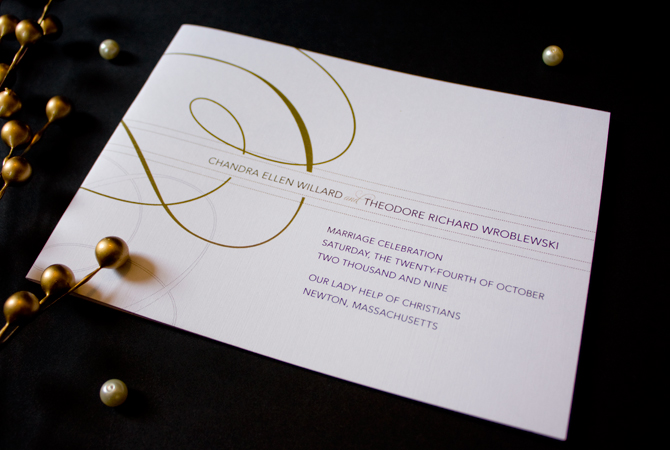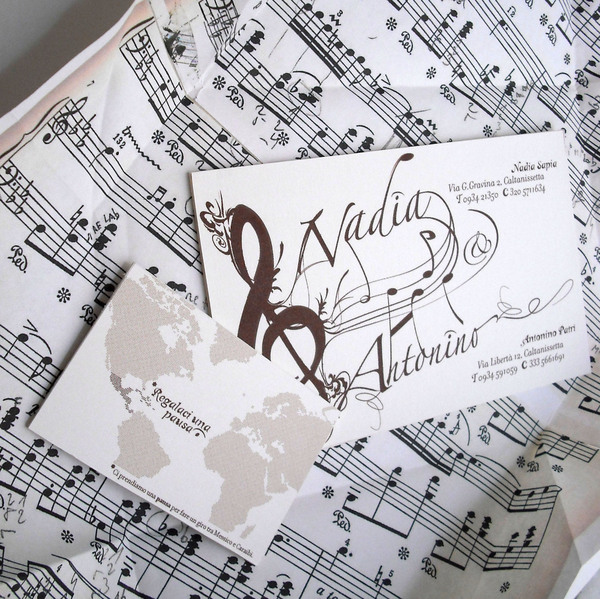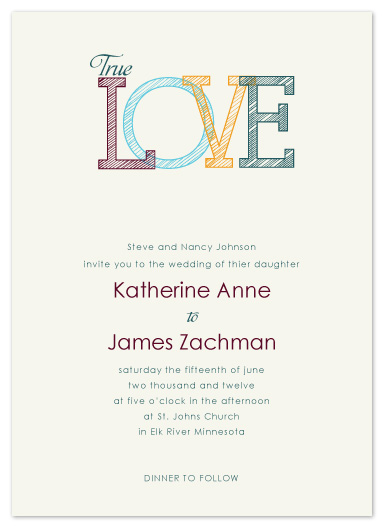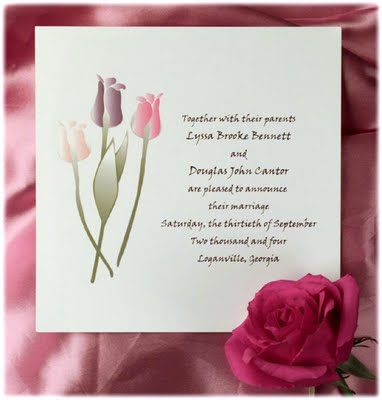Wedding Invitations
48 Wedding Invitation Samples Complete with Useful Tips
All couples want everything to be perfect for their wedding. From the entourage to the reception, each detail is carefully planned. They spend months, some even years, just to ensure things will go right for this special event. If you’re one of these soon-to-be weds, start by preparing your wedding invitations.
 www.thedesignski.com/346387/Silhouette-Wedding-Suite
www.thedesignski.com/346387/Silhouette-Wedding-Suite
Disclaimer: Images on this page are not owned by UPrinting and are used solely as design examples. Please use the links at the bottom of the images to see their original sources.
 www.thedesignski.com/346387/Silhouette-Wedding-Suite
www.thedesignski.com/346387/Silhouette-Wedding-SuiteMore than any lavish decorations or delicious menus, the presence of your family and friends matters the most. Create a personalized invitation for everyone in your guest list. You may forget to create engagement party invitations or invites for your elopement announcements but not for the big day itself. For unique and stunning wedding invitation designs, check these tips and samples below:
Create a classy and elegant design
Create a classy and elegant design
Use sans serif or script fonts and place intricate designs on the sides. If possible, avoid using more than two colors on your invites. This technique doesn’t only create elegant invitations, but it also ensures readability.
 www.behance.net/gallery/Wedding-Invitation/460461
www.behance.net/gallery/Wedding-Invitation/460461
 cargocollective.com/triciaseverson/1625672/Invitations
cargocollective.com/triciaseverson/1625672/Invitations
 www.coroflot.com/public/image_file.asp?portfolio_id=5598259&individual_id=321874&s=0&v=4&a=5&t=0
www.coroflot.com/public/image_file.asp?portfolio_id=5598259&individual_id=321874&s=0&v=4&a=5&t=0
 www.coroflot.com/public/image_file.asp?portfolio_id=5598256&individual_id=321874&s=0&v=4&a=5&t=0
www.coroflot.com/public/image_file.asp?portfolio_id=5598256&individual_id=321874&s=0&v=4&a=5&t=0
 pichollywood.blogspot.com/2011/03/simple-inexpensive-wedding-invitations.html
pichollywood.blogspot.com/2011/03/simple-inexpensive-wedding-invitations.html
 www.behance.net/gallery/Miguel-Gisele-Wedding-Invite/527173
www.behance.net/gallery/Miguel-Gisele-Wedding-Invite/527173
 www.behance.net/gallery/Wedding-Invitation/266406
www.behance.net/gallery/Wedding-Invitation/266406
 cargocollective.com/letodesign/296224/Amy-Arthur
cargocollective.com/letodesign/296224/Amy-Arthur
 cargocollective.com/TizianaFata/570823/Wedding-Invitations
cargocollective.com/TizianaFata/570823/Wedding-Invitations
 cargocollective.com/delaneme/570494/Wedding-Invitations
cargocollective.com/delaneme/570494/Wedding-Invitations
 www.ucreative.com/photo/wedding-invitation-and
www.ucreative.com/photo/wedding-invitation-and
 pichollywood.blogspot.com/2011/03/simple-inexpensive-wedding-invitations.html
pichollywood.blogspot.com/2011/03/simple-inexpensive-wedding-invitations.html
 www.coroflot.com/public/image_file.asp?portfolio_id=5520026&individual_id=138576&s=0&v=4&a=5&t=0
www.coroflot.com/public/image_file.asp?portfolio_id=5520026&individual_id=138576&s=0&v=4&a=5&t=0
 www.coroflot.com/public/image_file.asp?portfolio_id=5016165&individual_id=386535&s=0&v=4&a=5&t=0
www.coroflot.com/public/image_file.asp?portfolio_id=5016165&individual_id=386535&s=0&v=4&a=5&t=0
 www.coroflot.com/public/image_file.asp?portfolio_id=4949846&individual_id=163337&s=0&v=4&a=5&t=0
www.coroflot.com/public/image_file.asp?portfolio_id=4949846&individual_id=163337&s=0&v=4&a=5&t=0
Play with ribbons
Choose the appropriate size and type of ribbons for your wedding invitations. Use chiffon or satin to achieve a more stylish effect. Place them at the center or corner of your print.
 www.coroflot.com/public/image_file.asp?portfolio_id=5614803&individual_id=363188&s=0&v=4&a=5&t=0
www.coroflot.com/public/image_file.asp?portfolio_id=5614803&individual_id=363188&s=0&v=4&a=5&t=0
 www.coroflot.com/public/image_file.asp?portfolio_id=5215131&individual_id=126287&s=0&v=4&a=5&t=0
www.coroflot.com/public/image_file.asp?portfolio_id=5215131&individual_id=126287&s=0&v=4&a=5&t=0
 www.coroflot.com/public/image_file.asp?portfolio_id=5181605&individual_id=394846&s=0&v=4&a=5&t=0
www.coroflot.com/public/image_file.asp?portfolio_id=5181605&individual_id=394846&s=0&v=4&a=5&t=0
 www.behance.net/gallery/Wedding-Invitation/709390
www.behance.net/gallery/Wedding-Invitation/709390
 www.coroflot.com/public/image_file.asp?portfolio_id=5465340&individual_id=281099&s=0&v=4&a=5&t=0
www.coroflot.com/public/image_file.asp?portfolio_id=5465340&individual_id=281099&s=0&v=4&a=5&t=0
Go for folded invitations to maximize space
Flat invitations do work. But, if you want to include more details without making the invitation crowded, try using folded ones. Folded wedding invitations provide you added area where you can place intricate designs and write important information. You can place a simple decoration on the cover and write the rest inside.
 www.behance.net/gallery/rnb-wedding-invitation/281470
www.behance.net/gallery/rnb-wedding-invitation/281470
 browse.deviantart.com/?q=wedding%20invitation&order=9&offset=504#/d315ws0
browse.deviantart.com/?q=wedding%20invitation&order=9&offset=504#/d315ws0
 www.behance.net/gallery/Letterpress-Wedding-Stationery/311457
www.behance.net/gallery/Letterpress-Wedding-Stationery/311457
 cargocollective.com/whitepepper/2612/Tina-Craig
cargocollective.com/whitepepper/2612/Tina-Craig
 cargocollective.com/isabellegondran/117216/Wedding-Celebrations
cargocollective.com/isabellegondran/117216/Wedding-Celebrations
Use unusual colors
Invitations commonly use light colors for the background and stronger colors for the fonts. You can always choose the other way. Capture your guest’s attention by printing invitations with bright dominant colors.
 www.allcatsaregreyprints.com/1160102/WEDDING-BELLS
www.allcatsaregreyprints.com/1160102/WEDDING-BELLS
 cargocollective.com/DeRosa/133851/Wedding-Invites
cargocollective.com/DeRosa/133851/Wedding-Invites
 www.behance.net/gallery/My-wedding-invitations/421218
www.behance.net/gallery/My-wedding-invitations/421218
Include pictures
Images make your invitations more interesting. Include your favorite couple shot or use graphic illustrations or pictures of your wedding venue. Wedding invitation templates can make your life easier as you create your wedding invites. There are several templates available online which you can simply edit to incorporate your desired design in line with your theme or motif.
 cargocollective.com/goodmorningjulie/3272/stationery-design
cargocollective.com/goodmorningjulie/3272/stationery-design
 www.behance.net/gallery/Wedding-invitations/240648
www.behance.net/gallery/Wedding-invitations/240648
 cargocollective.com/goodmorningjulie/3272/stationery-design
cargocollective.com/goodmorningjulie/3272/stationery-design
 cargocollective.com/search/wedding%20invitations
cargocollective.com/search/wedding%20invitations
 adamelwell.com/1683617/Staley-Wedding-Invitations
adamelwell.com/1683617/Staley-Wedding-Invitations
 cargocollective.com/search/wedding%20invitations
cargocollective.com/search/wedding%20invitations
Find matching envelopes
Establish a more formal or personal look for your invites by sending them to the recipients enclosed in envelopes. Select brighter and stronger colored envelopes to partner with simple and plain invitations.
 cargocollective.com/martaharding/866096/Wedding-Invitations
cargocollective.com/martaharding/866096/Wedding-Invitations
 www.coroflot.com/public/image_file.asp?portfolio_id=5520025&individual_id=138576&s=0&v=4&a=5&t=0
www.coroflot.com/public/image_file.asp?portfolio_id=5520025&individual_id=138576&s=0&v=4&a=5&t=0
 www.coroflot.com/public/image_file.asp?portfolio_id=4866381&individual_id=302840&s=0&v=4&a=5&t=0
www.coroflot.com/public/image_file.asp?portfolio_id=4866381&individual_id=302840&s=0&v=4&a=5&t=0
 www.coroflot.com/public/image_file.asp?portfolio_id=4975526&individual_id=386861&s=0&v=4&a=5&t=0
www.coroflot.com/public/image_file.asp?portfolio_id=4975526&individual_id=386861&s=0&v=4&a=5&t=0
Attach necessary add-ons
Send your wedding invitations along with RSVP cards to help you confirm the number of attendees. Include a small map or a sketch of your wedding venue in your invitations to guide invitees to locate the place. Sample menu coupons may also be helpful to give guests an idea about what to expect in your reception.
 www.behance.net/gallery/Wedding-Invitation-Andrew-Lindsey/315455
www.behance.net/gallery/Wedding-Invitation-Andrew-Lindsey/315455
 www.coroflot.com/public/image_file.asp?portfolio_id=5355008&individual_id=404432&s=0&v=4&a=5&t=0
www.coroflot.com/public/image_file.asp?portfolio_id=5355008&individual_id=404432&s=0&v=4&a=5&t=0
 www.behance.net/gallery/BeyDunn-Wedding-Invitation/383971
www.behance.net/gallery/BeyDunn-Wedding-Invitation/383971
 www.coroflot.com/public/image_file.asp?portfolio_id=5317880&individual_id=215815&s=0&v=4&a=5&t=0
www.coroflot.com/public/image_file.asp?portfolio_id=5317880&individual_id=215815&s=0&v=4&a=5&t=0
 cargocollective.com/goodmorningjulie/3272/stationery-design
cargocollective.com/goodmorningjulie/3272/stationery-design
 cargocollective.com/search/wedding
cargocollective.com/search/wedding
 cargocollective.com/luxandtonic/410302/Wedding-Invitations
cargocollective.com/luxandtonic/410302/Wedding-Invitations
 www.behance.net/gallery/The-Wedding-of-Crystal-Jacob/1192211
www.behance.net/gallery/The-Wedding-of-Crystal-Jacob/1192211
 browse.deviantart.com/?qh=§ion=&q=wedding+invitations#/d39t0aj
browse.deviantart.com/?qh=§ion=&q=wedding+invitations#/d39t0aj
Can’t get enough of these design samples? Browse other article pages to give you more ideas and tips about custom invitation designs.
 www.behance.net/gallery/Wedding-Invitation/460461
www.behance.net/gallery/Wedding-Invitation/460461 cargocollective.com/triciaseverson/1625672/Invitations
cargocollective.com/triciaseverson/1625672/Invitations www.coroflot.com/public/image_file.asp?portfolio_id=5598259&individual_id=321874&s=0&v=4&a=5&t=0
www.coroflot.com/public/image_file.asp?portfolio_id=5598259&individual_id=321874&s=0&v=4&a=5&t=0 www.coroflot.com/public/image_file.asp?portfolio_id=5598256&individual_id=321874&s=0&v=4&a=5&t=0
www.coroflot.com/public/image_file.asp?portfolio_id=5598256&individual_id=321874&s=0&v=4&a=5&t=0 pichollywood.blogspot.com/2011/03/simple-inexpensive-wedding-invitations.html
pichollywood.blogspot.com/2011/03/simple-inexpensive-wedding-invitations.html www.behance.net/gallery/Miguel-Gisele-Wedding-Invite/527173
www.behance.net/gallery/Miguel-Gisele-Wedding-Invite/527173 www.behance.net/gallery/Wedding-Invitation/266406
www.behance.net/gallery/Wedding-Invitation/266406 cargocollective.com/letodesign/296224/Amy-Arthur
cargocollective.com/letodesign/296224/Amy-Arthur cargocollective.com/TizianaFata/570823/Wedding-Invitations
cargocollective.com/TizianaFata/570823/Wedding-Invitations cargocollective.com/delaneme/570494/Wedding-Invitations
cargocollective.com/delaneme/570494/Wedding-Invitations www.ucreative.com/photo/wedding-invitation-and
www.ucreative.com/photo/wedding-invitation-and pichollywood.blogspot.com/2011/03/simple-inexpensive-wedding-invitations.html
pichollywood.blogspot.com/2011/03/simple-inexpensive-wedding-invitations.html www.coroflot.com/public/image_file.asp?portfolio_id=5520026&individual_id=138576&s=0&v=4&a=5&t=0
www.coroflot.com/public/image_file.asp?portfolio_id=5520026&individual_id=138576&s=0&v=4&a=5&t=0 www.coroflot.com/public/image_file.asp?portfolio_id=5016165&individual_id=386535&s=0&v=4&a=5&t=0
www.coroflot.com/public/image_file.asp?portfolio_id=5016165&individual_id=386535&s=0&v=4&a=5&t=0 www.coroflot.com/public/image_file.asp?portfolio_id=4949846&individual_id=163337&s=0&v=4&a=5&t=0
www.coroflot.com/public/image_file.asp?portfolio_id=4949846&individual_id=163337&s=0&v=4&a=5&t=0Play with ribbons
Choose the appropriate size and type of ribbons for your wedding invitations. Use chiffon or satin to achieve a more stylish effect. Place them at the center or corner of your print.
 www.coroflot.com/public/image_file.asp?portfolio_id=5614803&individual_id=363188&s=0&v=4&a=5&t=0
www.coroflot.com/public/image_file.asp?portfolio_id=5614803&individual_id=363188&s=0&v=4&a=5&t=0 www.coroflot.com/public/image_file.asp?portfolio_id=5215131&individual_id=126287&s=0&v=4&a=5&t=0
www.coroflot.com/public/image_file.asp?portfolio_id=5215131&individual_id=126287&s=0&v=4&a=5&t=0 www.coroflot.com/public/image_file.asp?portfolio_id=5181605&individual_id=394846&s=0&v=4&a=5&t=0
www.coroflot.com/public/image_file.asp?portfolio_id=5181605&individual_id=394846&s=0&v=4&a=5&t=0 www.behance.net/gallery/Wedding-Invitation/709390
www.behance.net/gallery/Wedding-Invitation/709390 www.coroflot.com/public/image_file.asp?portfolio_id=5465340&individual_id=281099&s=0&v=4&a=5&t=0
www.coroflot.com/public/image_file.asp?portfolio_id=5465340&individual_id=281099&s=0&v=4&a=5&t=0Go for folded invitations to maximize space
Flat invitations do work. But, if you want to include more details without making the invitation crowded, try using folded ones. Folded wedding invitations provide you added area where you can place intricate designs and write important information. You can place a simple decoration on the cover and write the rest inside.
 www.behance.net/gallery/rnb-wedding-invitation/281470
www.behance.net/gallery/rnb-wedding-invitation/281470 browse.deviantart.com/?q=wedding%20invitation&order=9&offset=504#/d315ws0
browse.deviantart.com/?q=wedding%20invitation&order=9&offset=504#/d315ws0 www.behance.net/gallery/Letterpress-Wedding-Stationery/311457
www.behance.net/gallery/Letterpress-Wedding-Stationery/311457 cargocollective.com/whitepepper/2612/Tina-Craig
cargocollective.com/whitepepper/2612/Tina-Craig cargocollective.com/isabellegondran/117216/Wedding-Celebrations
cargocollective.com/isabellegondran/117216/Wedding-CelebrationsUse unusual colors
Invitations commonly use light colors for the background and stronger colors for the fonts. You can always choose the other way. Capture your guest’s attention by printing invitations with bright dominant colors.
 www.allcatsaregreyprints.com/1160102/WEDDING-BELLS
www.allcatsaregreyprints.com/1160102/WEDDING-BELLS cargocollective.com/DeRosa/133851/Wedding-Invites
cargocollective.com/DeRosa/133851/Wedding-Invites www.behance.net/gallery/My-wedding-invitations/421218
www.behance.net/gallery/My-wedding-invitations/421218Include pictures
Images make your invitations more interesting. Include your favorite couple shot or use graphic illustrations or pictures of your wedding venue. Wedding invitation templates can make your life easier as you create your wedding invites. There are several templates available online which you can simply edit to incorporate your desired design in line with your theme or motif.
 cargocollective.com/goodmorningjulie/3272/stationery-design
cargocollective.com/goodmorningjulie/3272/stationery-design www.behance.net/gallery/Wedding-invitations/240648
www.behance.net/gallery/Wedding-invitations/240648 cargocollective.com/goodmorningjulie/3272/stationery-design
cargocollective.com/goodmorningjulie/3272/stationery-design cargocollective.com/search/wedding%20invitations
cargocollective.com/search/wedding%20invitations adamelwell.com/1683617/Staley-Wedding-Invitations
adamelwell.com/1683617/Staley-Wedding-Invitations cargocollective.com/search/wedding%20invitations
cargocollective.com/search/wedding%20invitationsFind matching envelopes
Establish a more formal or personal look for your invites by sending them to the recipients enclosed in envelopes. Select brighter and stronger colored envelopes to partner with simple and plain invitations.
 cargocollective.com/martaharding/866096/Wedding-Invitations
cargocollective.com/martaharding/866096/Wedding-Invitations www.coroflot.com/public/image_file.asp?portfolio_id=5520025&individual_id=138576&s=0&v=4&a=5&t=0
www.coroflot.com/public/image_file.asp?portfolio_id=5520025&individual_id=138576&s=0&v=4&a=5&t=0 www.coroflot.com/public/image_file.asp?portfolio_id=4866381&individual_id=302840&s=0&v=4&a=5&t=0
www.coroflot.com/public/image_file.asp?portfolio_id=4866381&individual_id=302840&s=0&v=4&a=5&t=0 www.coroflot.com/public/image_file.asp?portfolio_id=4975526&individual_id=386861&s=0&v=4&a=5&t=0
www.coroflot.com/public/image_file.asp?portfolio_id=4975526&individual_id=386861&s=0&v=4&a=5&t=0Attach necessary add-ons
Send your wedding invitations along with RSVP cards to help you confirm the number of attendees. Include a small map or a sketch of your wedding venue in your invitations to guide invitees to locate the place. Sample menu coupons may also be helpful to give guests an idea about what to expect in your reception.
 www.behance.net/gallery/Wedding-Invitation-Andrew-Lindsey/315455
www.behance.net/gallery/Wedding-Invitation-Andrew-Lindsey/315455 www.coroflot.com/public/image_file.asp?portfolio_id=5355008&individual_id=404432&s=0&v=4&a=5&t=0
www.coroflot.com/public/image_file.asp?portfolio_id=5355008&individual_id=404432&s=0&v=4&a=5&t=0 www.behance.net/gallery/BeyDunn-Wedding-Invitation/383971
www.behance.net/gallery/BeyDunn-Wedding-Invitation/383971 www.coroflot.com/public/image_file.asp?portfolio_id=5317880&individual_id=215815&s=0&v=4&a=5&t=0
www.coroflot.com/public/image_file.asp?portfolio_id=5317880&individual_id=215815&s=0&v=4&a=5&t=0 cargocollective.com/goodmorningjulie/3272/stationery-design
cargocollective.com/goodmorningjulie/3272/stationery-design cargocollective.com/search/wedding
cargocollective.com/search/wedding cargocollective.com/luxandtonic/410302/Wedding-Invitations
cargocollective.com/luxandtonic/410302/Wedding-Invitations www.behance.net/gallery/The-Wedding-of-Crystal-Jacob/1192211
www.behance.net/gallery/The-Wedding-of-Crystal-Jacob/1192211 browse.deviantart.com/?qh=§ion=&q=wedding+invitations#/d39t0aj
browse.deviantart.com/?qh=§ion=&q=wedding+invitations#/d39t0ajCan’t get enough of these design samples? Browse other article pages to give you more ideas and tips about custom invitation designs.

